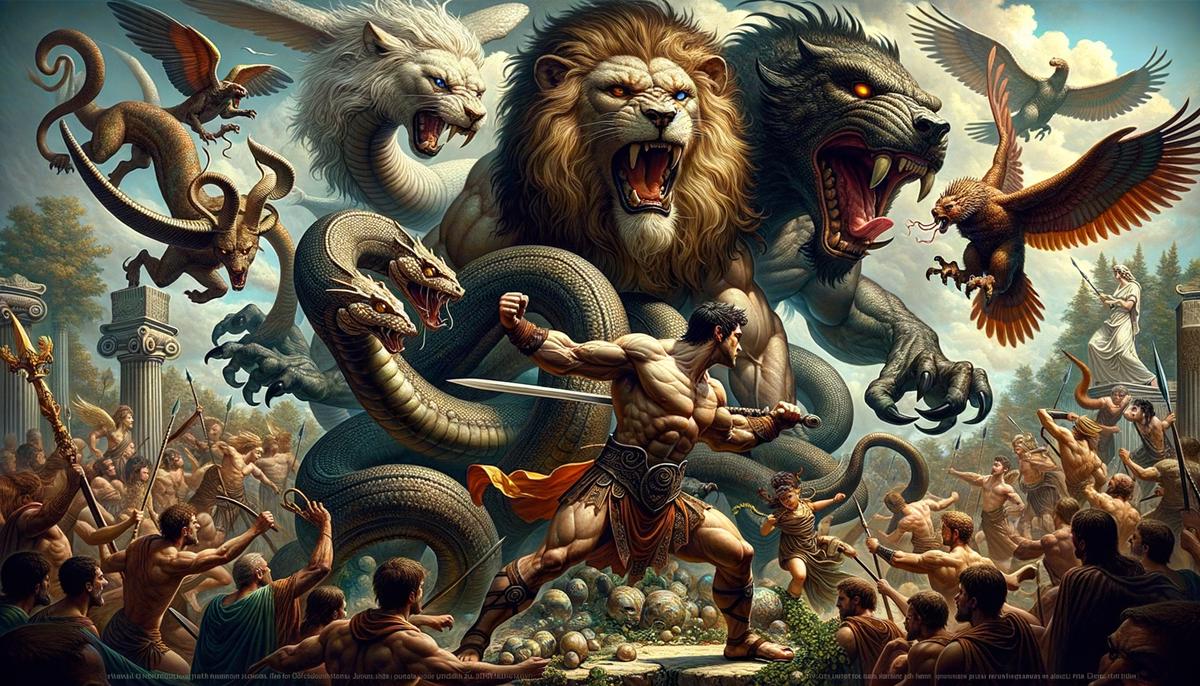vcdiversity.org – Hercules, also known as Heracles in Greek mythology, is one of the most celebrated heroes in ancient stories. Born with immense strength, he was the son of Zeus, the king of the gods, and a mortal woman named Alcmene. Hercules’ life was filled with trials and tribulations, but his courage and determination made him a symbol of heroism and perseverance.
The Twelve Labors of Hercules
The most famous tales of Hercules revolve around his twelve labors, tasks he was commanded to complete as penance for killing his wife and children, a deed done under the influence of Hera, Zeus’s jealous wife. These labors were designed to be impossible, yet Hercules, with his wit and strength, managed to overcome each challenge.
1. The Nemean Lion
Hercules’ first labor was to slay the Nemean Lion, a beast with impenetrable skin. Unable to harm the lion with his arrows, Hercules resorted to wrestling it with his bare hands, eventually strangling it to death. He then used one of the lion’s own claws to skin it, creating a cloak that would protect him in future battles.
2. The Lernaean Hydra
The second labor involved defeating the Lernaean Hydra, a serpentine monster with multiple heads. Each time one head was cut off, two more would grow back. Hercules enlisted the help of his nephew Iolaus, who would cauterize the neck stumps to prevent new heads from growing. After defeating the Hydra, Hercules dipped his arrows in its poisonous blood, making them deadly.
3. The Ceryneian Hind
Hercules was tasked with capturing the Ceryneian Hind, a golden-horned deer, without harming it. After a year-long chase, he managed to capture the hind and bring it back to his king, showcasing his patience and skill in hunting.
4. The Erymanthian Boar
The fourth labor required Hercules to capture the Erymanthian Boar, a giant and ferocious beast. He chased the boar through deep snow and into a thicket, where he trapped and subdued it, demonstrating his bravery and determination.
5. The Augean Stables
Hercules’ fifth task was to clean the stables of King Augeas, home to thousands of cattle, in a single day. By diverting the rivers Alpheus and Peneus, Hercules managed to wash away the filth, completing the labor with ingenuity rather than brute force.
6. The Stymphalian Birds
The Stymphalian Birds, man-eating creatures with bronze beaks and sharp metallic feathers, were the sixth challenge. Hercules used a rattle given by Hephaestus to frighten the birds into the air, then shot them down with his arrows.
7. The Cretan Bull
Hercules had to capture the Cretan Bull, a ferocious beast that was terrorizing Crete. After a fierce battle, he subdued the bull and brought it back to Greece, showcasing his unmatched strength.
8. The Mares of Diomedes
The eighth labor involved capturing the man-eating mares of Diomedes, the king of the Bistones. Hercules defeated Diomedes and fed him to his own horses, taming them and leading them back to Greece.
9. The Belt of Hippolyta
Hercules was tasked with obtaining the belt of Hippolyta, the queen of the Amazons. Initially, Hippolyta agreed to give him the belt, but Hera, disguised as an Amazon, spread a rumor that Hercules was abducting their queen. A battle ensued, and Hercules killed Hippolyta, taking the belt by force.
10. The Cattle of Geryon
The tenth labor required Hercules to bring back the cattle of Geryon, a monster with three bodies. After a long journey, Hercules encountered and killed Geryon, driving the cattle back to Greece.
11. The Apples of the Hesperides
Hercules’ eleventh task was to retrieve the golden apples from the Garden of the Hesperides. With the help of Atlas, who held up the sky, Hercules managed to obtain the apples, using his wits to trick Atlas into completing the task for him.
12. Cerberus
The final labor was to capture Cerberus, the three-headed dog that guarded the entrance to the Underworld. Hercules, with his strength and courage, managed to subdue Cerberus and bring him to the surface, completing his twelve labors.
Legacy of Hercules
Hercules’ twelve labors are a testament to his strength, courage, and determination. These tales have been passed down through generations, inspiring stories, art, and even modern adaptations. Hercules remains a symbol of heroism, a demigod whose adventures continue to captivate the imagination of people around the world.

